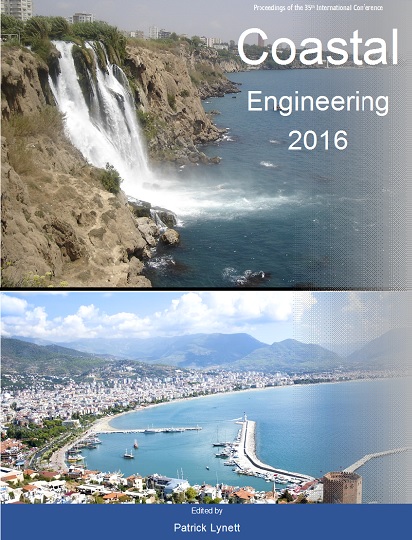Abstract
In this study, wave height evolution and wave setup were measured in a laboratory wave tank with a sloping beach covered with rigid and flexible artificial vegetation under regular and irregular wave conditions. The experiments were conducted in a 20.6 m long, 0.69 m wide and 1.22 m deep wave tank at the USDA-ARS National Sedimentation Laboratory, Oxford, MS, USA. Regular and irregular waves were generated using a computer controlled piston type wave generator. A plane wooden beach with a 1:21 slope was constructed at the down-wave end of the wave tank, 11.5 m away from the wave paddle. Rigid vegetation was constructed out of wooden dowels and flexible vegetation was constructed using polyurethane tubes. Both vegetation models were 3.1 mm in diameter and 0.2 m long and had a population density of 3,182 stems/m2. The results were compared with those from experiments on a non-vegetated plane beach. Both rigid and flexible vegetation models reduced the wave height and wave setup substantially, but rigid vegetation typically performed better in reducing wave setup. For some of the experiments, no wave breaking was observed over the vegetated models, indicating that wave attenuation due to vegetation reduced the shoaling rate. For other experiments, wave breaking was observed and wave height attenuation was very small; however, wave setup was still significantly lower than in the plane beach experiments.References
Asano, T., Tsutsui, S., and Sakai T. 1988. Wave damping characteristics due to seaweed. Proceedings of the 25th International Coastal Engineering Conference (ICEC' 88).
Bowen, A.J., Inman, D.L. and Simmons, V.P., 1968. Wave 'set†down'and set†Up. Journal of Geophysical Research, 73(8), pp.2569-2577.
Dalrymple, R.A., Kirby, J.T. and Hwang, P.A., 1984. Wave diffraction due to areas of energy dissipation. Journal of Waterway, Port, Coastal, and Ocean Engineering, 110(1), pp.67-79.
Dean, R.G., and Bender, C.J. 2006. Static wave setup with emphasis on damping effects by vegetation and bottom friction. Journal of Coastal Engineering 53, 149-156.
Harris, D.L., 1963. Characteristics of the hurricane storm surge. Department of Commerce, Weather Bureau.
Komar, P. D. 1998. Beach Processes and Sedimentation. Prentice-Hall. Inc., Englewood Cliffs, NJ.
Longuet-Higgins, M.S. and Stewart, R.W., 1962. Radiation stress and mass transport in gravity waves, with application to 'surf beats'. Journal of Fluid Mechanics, 13(04), pp.481-504.
Longuet-Higgins, M.S. and Stewart, R.W., 1964, August. Radiation stresses in water waves; a physical discussion, with applications. In Deep Sea Research and Oceanographic Abstracts (Vol. 11, No. 4, pp. 529-562). Elsevier.
Longuet-Higgins, M.S., 2005. On wave set-up in shoaling water with a rough sea bed. Journal of Fluid Mechanics, 527, pp.217-234.
Mendez, F. J. and Losada., I. J., 2004. An empirical model to estimate the propagation of random breaking and nonbreaking waves over vegetation fields. Coastal Engineering, 51: 103-118.
Ozeren, Y., Wren, D.G. and Wu, W., 2014. Experimental investigation of wave attenuation through model and live vegetation. Journal of Waterway, Port, Coastal, and Ocean Engineering, 140(5), p.04014019.
van Rooijen, A.A., McCall, R.T., van Thiel de Vries, J.S.M., van Dongeren, A.R., Reniers, A.J.H.M. and Roelvink, J.A., 2016. Modeling the effect of wave†vegetation interaction on wave setup. Journal of Geophysical Research: Oceans, 121(6), pp.4341-4359.
Wu, W., Ozeren, Y., Wren, D., Chen, Q., Zhang, G., Holland, M., Ding, Y., Kuiry, S.N., Zhang, M., Jadhav, R. and Chatagnier, J., 2011. Investigation of surge and wave reduction by vegetation. Phase I Report for SERRI Project No. 80037, The University of Mississippi, MS, 315p.

